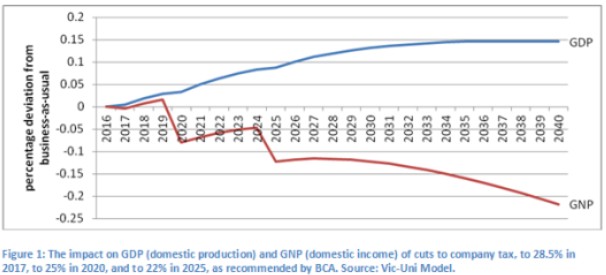Chris Murphy, the Independent Economics economist commissioned by The Treasury to model the Turnbull Government’s company tax cut, has hit back at critics, sticking to his position that a company tax cut would deliver huge benefits to consumers. From The AFR:
…for every $1 of cost to the government budget, the company tax cut provides a gross benefit to consumers of $2.39 in the long run (using unrounded benefits and costs). If you cut any of the other major taxes such as personal income tax or the GST, the consumer benefit is nowhere near as large for each dollar of budget cost. It is also difficult to think of a government spending proposal that would offer such a high pay-off ratio.
However, Victoria University senior research fellow, Janine Dixon, disagrees with Murphy’s arguments, questioning the purported benefits in a counter-piece in The AFR:
It’s quite possible that GDP will go up but domestic incomes will fall, and that wages will go up but post-tax wages will fall. The tax cut is supposed to be good for business, but owners of small businesses paying franked dividends are unable to see how they will be better off…
An important element of the result for consumer welfare is the effect of reduced tax avoidance. The logic is that if the company tax rate is lower, companies won’t put as much effort into avoiding it. This is attributed to rational behaviour, not an attack of conscience or morality.
On this estimation, reduced profit shifting will return $4 billion to the income of Australians every year, in the long run. In the context of a policy that according to the same modelling delivers a gain to consumer welfare of $5 billion at most, this figure requires careful scrutiny…
Although tax avoidance may be reduced somewhat, with a domestic tax rate of 25 per cent compared to tax havens charging little or no tax, incentives to dodge tax will remain in place. It is unlikely that tax avoidance would be almost eliminated, as the $4 billion estimate suggests. If, as is likely, this estimate is too large, gains to consumer welfare will be similarly overstated.
Dixon is not the first to question the ‘morality dividend’ assumed by Murphy – i.e. the assumption that foreign corporations will cease ‘profit shifting’ if the company tax rate is reduced to 25% to 30%. The Australia Institute’s chief economist, Richard Denniss, has also previously debunked this claim:
“Our research has uncovered that the Treasury commissioned modelling finds a $3.9B gain in government revenue because multinationals suddenly and voluntarily begin to pay more tax because the company tax rate drops 5 percentage points. It is preposterous,” Chief Economist of The Australia Institute, Richard Denniss said.
“The economic modelling commissioned by Treasury and released on budget night estimates that 55 per cent of the $8.2 billion per year cost of the tax cuts could be ‘self-funded’. However almost all of this ‘self-funding’ flows from the assumption that multinational tax minimisation will dramatically drop because the company tax rate is cut by a sixth from 30 per cent to 25 per cent
“If this assumption does not materialise, the revenue would have to be found from increased taxes.
“Despite its $48 billion cost, there has been no cost benefit analysis of the company tax cuts. What modelling exists shows that the tax cuts will cost billions in lost revenue up front and then deliver tiny benefits are decades away. If this was a freeway it would never be built…
Indeed, Murphy’s own modelling shows minimal benefit to employment or growth from the proposed $48 billion company tax cut, as noted by Peter Martin:
The Independent Economics modelling finds that after several decades the $8 billion per year would lift living standards by between $5 billion and $9 billion. That’s not an increase of $5 billion to $9 billion per year, its an eventual increase that would be maintained. As a proportion of gross national income it is somewhere between 0.5 and 0.7 per cent. As an increase per year it is less than 0.1 per cent. Rounded to one decimal place it is 0.0 per cent.
And the boost to jobs would be even smaller. Independent Economics says employment would eventually climb by 0.17 per cent if the tax cut was funded by a tax on households, or by as little as 0.02 if it was funded by cutting government spending. That’s an eventual increase of between 2400 and 20,400 jobs. By way of comparison employment has climbed by an average of 24,400 per month each over the past year. It means that after 20 to 30 years the $8 billion per year holds out the prospect of delivering an extra month’s worth of employment growth.
It’s not many jobs and not much growth…
Let’s also not forget that rival modelling from Janine Dixon showed that cutting company taxes could actually reduce national income – the best measure of living standards – because the lion’s share of the benefits would flow offshore:

Hardly seems like a good deal for taxpayers, does it?
That’s why a growing conga-line of commentators and analysts are queuing up against the Coalition’s proposed company tax cut. Along with Janine Dixon, Richard Denniss and Peter Martin, there’s Fairfax writers Ross Gittins, Michael Pascoe, and Mark Kenny who have raised concerns.
Think tank The Grattan Institute has joined The Australia Institute in debunking the modelling supporting the company tax cut, as has the ABC’s investigative reporter Stephen Long.
Meanwhile, Goldman Sachs has questioned the purported benefits, as has former Liberal leader John Hewson.
It seems nearly everyone but Murphy thinks the Coalition’s company tax cut is an expensive dud that should be abandoned.

